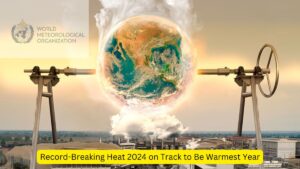 The year 2024 has gone down as the hottest ever recorded in the South-West Pacific, according to a new report by the World Meteorological Organization (WMO). The region faced record-breaking temperatures, destructive cyclones, extreme rainfall, severe droughts, and the largest marine heatwave ever seen.
The year 2024 has gone down as the hottest ever recorded in the South-West Pacific, according to a new report by the World Meteorological Organization (WMO). The region faced record-breaking temperatures, destructive cyclones, extreme rainfall, severe droughts, and the largest marine heatwave ever seen.
The “State of the Climate in the South-West Pacific 2024” report, released on June 5, 2025, paints a worrying picture of rising climate risks for countries including Australia, Indonesia, the Philippines, Fiji, and New Zealand.
The region’s land and ocean temperatures broke all previous records, even surpassing the heat of 2023. Much of this warming was linked to the strong 2023/2024 El Niño event, which pushed temperatures higher and left lingering effects long after it ended.
A year of climate extremes
From Malaysia to southern Australia, countries experienced temperatures between 0.5°C to 1°C above the 1991-2020 average. Brunei, Singapore, and the Philippines saw their hottest year ever. Western Australia faced an unprecedented heatwave in February, with Carnarvon recording a scorching 49.9°C and Geraldton 49.3°C—both smashing century-old records by over 2°C. Emu Creek hit 48°C for four straight days, setting a national record.

But heat was only part of the story. El Niño brought severe drought to southern Australia, New Zealand’s north, and Pacific islands such as New Caledonia, Cook Islands, and Hawaii—some of the driest conditions in 30 years. Meanwhile, northern Australia, Papua New Guinea, and parts of Malaysia and Indonesia were drenched with the heaviest rainfall in decades.
Cyclone season also turned severe, with the Philippines suffering 12 named storms between September and November 2024—double the usual number. Major storms like Trami, Kong-rey, and Toraji caused widespread destruction, inflicting over $430 million in damages.
Oceans hit dangerous highs
The sea surface temperature in 2024 was the highest ever recorded, with vast stretches of ocean suffering extreme marine heatwaves. Around 40 million square kilometres—more than 10 per cent of the world’s ocean surface—were affected, the largest area ever recorded, even greater than previous peaks in 2016 and 2023.
These marine heatwaves disrupt fisheries, coral reefs, and marine ecosystems vital to coastal communities’ food and economy.
Glaciers in western New Guinea and Indonesia shrank by up to 50 per cent between April 2022 and August 2024. If this pace continues, all remaining tropical glaciers could vanish by 2026.
Sea-level rise threatens island nations
Rising temperatures are melting ice and expanding ocean waters, pushing sea levels in the South-West Pacific up faster than the global average of 3.5 mm a year. In Fiji’s Serua Province, sea-level rise has already destroyed homes, washed away farmland, and submerged parts of villages, causing serious damage to people’s livelihoods and food security.
“Sea-level rise is an existential threat to entire island nations. We are fast running out of time to turn the tide,” warned WMO Secretary-General Celeste Saulo.
Urgent action needed
The report urges governments to improve early warning systems and strengthen community-based disaster preparedness to protect lives and economies. Positive examples include the Philippines, where local engagement and proactive steps have reduced losses and preserved cultural heritage during disasters.
Since the WMO started tracking the South-West Pacific’s climate in 2020, every new report has shown worsening vulnerability to extreme weather, underlining the growing danger from climate change.
Without immediate, coordinated global action, the future for these nations and their people looks increasingly uncertain.
